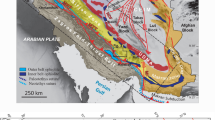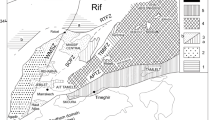Abstract.
Augen gneisses, mica schists, and marbles of the Menderes Massif and its sedimentary cover rocks are exposed south of the Gediz graben. The augen gneisses form the structurally lowest part of the studied lithological sequence, and are overlain by a schist complex. The structurally highest part is formed by a series of marbles. The ages of this lithological sequence range from Precambrian to Early Paleocene. Furthermore, this sequence records the tectonic evolution since the Precambrian. The sedimentary cover of the Menderes Massif consists of two groups of sediments from Early Miocene to Quaternary. The lower group, the Alaşehir group, consists of Early- to mid-Miocene-aged fluvial and limnic sediments which form the lower and the upper parts, respectively. The Alaşehir group is overlain by mainly fluvial sediments of the Gediz group. Both the Alaşehir and the Gediz groups are separated by an angular unconformity. Six deformational phases could be distinguished within the metamorphic rocks of the Menderes Massif and its Tertiary cover. The structures which were interpreted to belong to deformational events predating the Paleocene are summarized as deformational phase D1. D1 structures were nearly completely overprinted by the subsequent deformation events. The second deformational phase D2 occurred between Early Eocene and Early Oligocene. D2 occurred contemporaneously with a Barrovian-type regional metamorphism. The third deformational phase D3 is characterized by folding of the axial planes which formed at the end of Early Oligocene. The deformational event D4 occurred during the Late Oligocene and is related to an extensional period. The deposition of the sedimentary rocks which belong to the Tertiary cover of the Menderes Massif that started in the Early Miocene was interrupted by a compressional phase (D5) during the Late Miocene. Sediments which were deposited since the Early Pliocene record structures which were related to a young extensional phase (D6). This extensional phase has continued to the Present.
Similar content being viewed by others
Author information
Authors and Affiliations
Additional information
Electronic Publication
Rights and permissions
About this article
Cite this article
Gokten, E., Havzoğlu, T. & Şan, Ö. Tertiary evolution of the central Menderes Massif based on structural investigations of metamorphics and sedimentary cover rocks between Salihli and Kiraz (western Turkey). Int J Earth Sci 89, 745–756 (2001). https://doi.org/10.1007/s005310000099
Received:
Accepted:
Issue Date:
DOI: https://doi.org/10.1007/s005310000099




